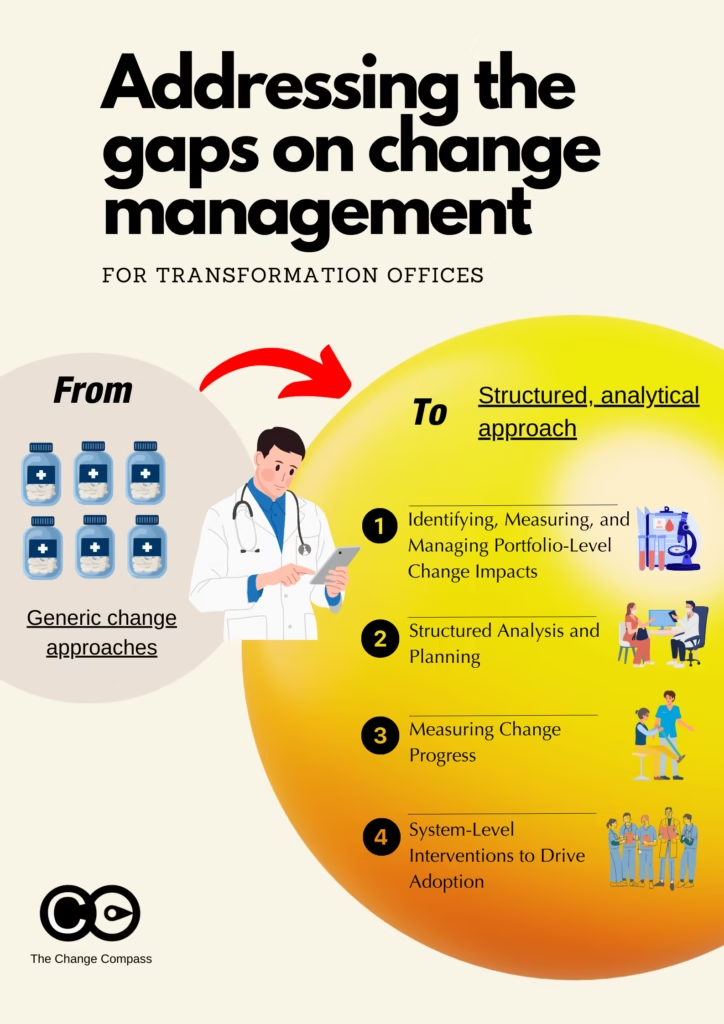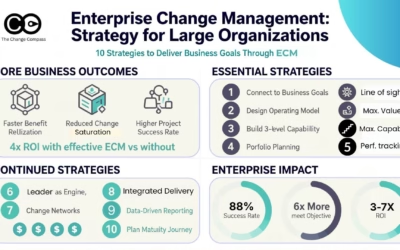For many organisations, transformation has become a strategic necessity. However, the success rate of large-scale transformation efforts remains low. There are various arguments about the actual percentage of success for transformation. Consulting firms often quote 30% as the standard, whilst others argue it may be up to 50%. There is also the issue of the definition of ‘transformation’ versus other change initiatives. Regardless, the actual level of success, most agree that this level needs to be much higher given the significant capital and resource focus on transformations across organisations. A critical but often overlooked factor? The way change is managed.
Despite the importance of change management, transformation offices and teams may not be taking the right approach. According to Sensei Labs’ 2024 State of Transformation survey, senior leaders in large organisations identified culture and change management as the second most pressing concern. When it comes to budget allocation, change management ranks third out of 10 of budget category expenditure ranking, following technology and consulting/advisory expenditures. Previous survey findings, such as Deloitte’s 2022 report show this expenditure to be even lower.
Note that this State of Transformation survey included over 150 respondents from various industries and largely from large organisations. Respondents were mostly Director and above level of seniority.
So, transformation offices acknowledge change management to be a key issue to be tackled, and a sizable budget is spent on various change support activities. So, what is the issues?
A Narrow Approach to Change
A concerning trend in transformation offices is that most only focus on communications, training, and stakeholder engagement as their primary change management activities. These are necessary components, but they are far from sufficient. Effective transformation requires more than just keeping employees informed and trained—it demands a structured, data-driven approach to managing change impact at scale.
Interestingly, the same Sensei Labs survey found that formal change management roles are largely absent within transformation functions. While many teams include Communications and Human Resources roles, only 14% reported having dedicated change management professionals. This absence may explain why change efforts fail to gain traction—without formalized expertise, the true complexity of change is not adequately addressed.
Another striking gap: only 12% of organisations reported measuring change impact. If change impact isn’t assessed, captured and measured, how can organisations get ready for something they are not exactly clear about at a detailed level? And subsequently how can organisations ensure adoption, sustainability, and business outcomes?

Without the clear understanding of impacts, how people will undergo change is not clear. As a result, organisations may take a ‘pan-all’ generic approach of engaging with groups of impacted functions teams, send lots of communications and put in place training sessions.
Without a precise and tailored approach to impacted stakeholder groups, change interventions may be hit or miss. It is the same as air traffic control in a busy airport. Will you use the same approach to chaperone and assist all planes to land in the same way, regardless if it’s a small chartered jet, a helicopter, a 747, a jumbo jet or a fighter jet? A helicopter doesn’t even need a runway like planes, and a fighter jet cannot land in the same area as a commercial landing zone. So, why would we not take a targeted approach at impacted stakeholder groups, each with its own unique change journey?
Addressing the Gaps in Driving Transformations
To close the gap in transformation success, organisations must rethink their approach to change management. This requires shifting from tactical, activity-based change management to a more strategic, structured, and measurable approach.
A change strategy is critical because it provides a structured, outcome-driven approach that aligns change activities with business objectives, rather than just executing a checklist of tasks. It ensures that change efforts are integrated, sustainable, and adaptive to organisational dynamics, rather than reactive and fragmented. A well-defined strategy considers stakeholder impact, capacity constraints, and potential risks, enabling leaders to make informed decisions that drive adoption and long-term success. Without it, change initiatives risk becoming disjointed efforts that fail to deliver meaningful business value.

Key areas of focus should include:
1. Identifying, Measuring, and Managing Portfolio-Level Change Impacts
Many transformation offices manage multiple concurrent initiatives, but few assess how these changes collectively impact employees, customers, and operations. A robust change portfolio management approach is needed to:
- Identify cumulative change impacts across projects
- Avoid change fatigue/capacity overload
- Prioritize initiatives based on organisational capacity and readiness
To properly assess portfolio-level impacts, organisations must develop frameworks that aggregate data across initiatives. By tracking concurrent and overlapping changes, leaders can identify where resistance may emerge and proactively address it. Portfolio-level visibility also enables executives to make better-informed decisions regarding project prioritization and resource allocation.
Identifying and mapping out impacts is one of the most critical pieces of work to ensure change outcome success. Why? It is because effectively identifying and structuring the change impacts on stakeholders determines the resulting change interventions. If your impact assessment is ineffective, your change interventions will not hit the mark.
This is exactly the same process as a doctor diagnosing the illness. The diagnosis process requires a structured assessment process. With the wrong diagnosis it leads to a wrong treatment plan. The wrong treatment plan will not result in curing the illness.
2. Structured Analysis and Planning
Organisations must integrate structured change planning into transformation execution, including:
- Complexity assessments to evaluate the scale and interdependencies of change initiatives
- Current-to-future state gap analysis to understand the magnitude of change
- Benefit realization planning to link change activities to business outcomes
- Transition plans to ensure a smooth shift from current to new ways of working
A structured approach allows organisations to proactively mitigate risks associated with transformation. Complexity assessments, for example, help organisations anticipate challenges in large-scale transformations, enabling leaders to develop targeted interventions. Additionally, linking change initiatives to tangible business outcomes ensures accountability and prevents change initiatives from being seen as purely theoretical exercises.
A doctor does not diagnose the illness based on a generic approach or gutfeel, or worse what others tell him/her to do. The treatment plan is also based on what has found to work through research. The same should also be applied with change analysis and planning.
3. Measuring Change Progress
Change success cannot be managed if it is not measured. Organisations should implement:
- Readiness assessments to gauge preparedness before rolling out initiatives
- Adoption metrics to track engagement and behavioural shifts post-implementation
- Feedback loops to identify resistance points and adjust strategies accordingly
Without clear metrics, organisations struggle to determine whether change initiatives are truly effective. Readiness assessments help gauge the level of preparedness within an organisation before implementation begins, while adoption metrics provide insight into how well employees are embracing new ways of working. Continuous feedback loops allow for real-time course corrections, ensuring that change efforts remain on track.
Using the same doctor-patient analogy, the doctor looks for observable data in order to assess the treatment progress. Modifications may be needed based on verbal patient feedback, observations, examinations, and reactions to medication, etc. Your change metrics should be designed to do the same, to tell you if you are progressing well towards the end state, or not.
4. System-Level Interventions to Drive Adoption
To make change stick, organisations need mechanisms that embed change into everyday operations. Key interventions include:
- Establishing Change Champions networks to support peer-led adoption
- Creating robust communication and capability support channels, ensuring ongoing guidance and reinforcement
- Embedding change metrics into enterprise dashboards to sustain leadership attention and accountability
Change Champions play a crucial role in accelerating adoption. These individuals serve as advocates within their teams, reinforcing key messages and addressing concerns on the ground. Robust communication and support channels, such as digital knowledge repositories and dedicated coaching sessions, help employees navigate the complexities of transformation. Moreover, integrating change metrics into enterprise dashboards ensures sustained leadership focus, preventing transformation initiatives from losing momentum over time.

The Risks of Inadequate Change Management
Organisations that neglect structured change management risk experiencing several common pitfalls:
- Missed Business Outcomes: If change is not strategically planned and measured, organisations may fail to realize the intended benefits of transformation efforts. And in fact this may be the most critical outcome.
- Employee Resistance: Without proper engagement and support mechanisms, employees are more likely to resist changes, leading to lower adoption rates.
- Change Fatigue: When multiple transformations occur simultaneously without proper coordination, employees can become overwhelmed, leading to disengagement.
- Increased Costs: Poorly managed change initiatives can lead to costly rework, delays, and productivity losses.
A more intentional approach to change management mitigates these risks, ensuring that transformation efforts drive sustainable, long-term value.
Building a High-Impact Change Management Capability
Transformation offices must evolve their approach to change management by developing a high-impact capability that aligns with enterprise priorities. This involves:
- Investing in Change Management Expertise: Hiring or upskilling professionals with deep expertise in change methodologies, behavioural science, and organisational psychology.
- Integrating Change Management with Strategy: Embedding change management into the transformation office’s strategic planning and execution processes.
- Leveraging AI and Automation: Utilizing AI-driven tools to assess change impact, track adoption trends, and provide data-driven insights.
- Cultivating Leadership Engagement: Ensuring senior leaders actively sponsor and advocate for change management efforts.
By institutionalizing these capabilities, transformation offices can enhance their ability to drive large-scale change successfully.
The Way Forward
Transformation leaders must move beyond outdated, activity-driven change management approaches that have resulted in transformation targets being missed and adopt a more structured, and data-informed model around people. By embedding change impact measurement, structured planning, and system-level interventions, transformation offices can significantly improve adoption, minimize resistance, and drive sustained business value.
The challenge is clear: without a fundamental shift in how change is managed, even the most well-funded transformations with full senior leadership support risk failure. It’s time for transformation offices to bridge this critical gap and take a more disciplined, structured approach to change management.
By doing so, organisations will not only improve transformation success rates but also foster a more adaptable and resilient workforce, ensuring long-term competitive advantage in an era of continuous change.






